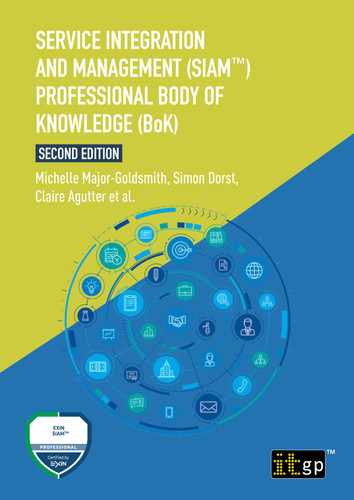CONTENTS
1.3History of the SIAM Foundation BoK
1.6.1Externally sourced service integrator
1.6.2Internally sourced service integrator
1.6.3Hybrid service integrator
1.6.4Lead supplier as service integrator
Chapter 2:SIAM roadmap stage 1: Discovery & Strategy
2.2Establish the SIAM transition project
2.2.1Project management methods
2.2.5Outcomes, objectives and benefits management
2.3Establish a SIAM governance framework
2.3.2Governance in a SIAM ecosystem
2.3.13Supplier and contract management
2.3.14Monitoring and measuring service performance
2.4Define principles and policies for roles and responsibilities
2.5.3The role of analysts, benchmarkers and advisors
2.5.4Current organizational capability
2.5.5Existing services and service groupings
2.5.6Existing service providers
2.5.7The customer organization
2.6.2Strategic drivers for SIAM
2.6.4Communicating the strategy
2.7Create an outline business case
2.7.1Create the outline SIAM model
2.8.1Capability (people/process) considerations
Chapter 3: SIAM roadmap stage 2: Plan & Build
3.1Design the detailed SIAM model
3.1.1Service model considerations
3.1.2Sourcing approach and the selected SIAM structure
3.1.3The importance of contracts in SIAM
3.1.6Detailed roles and responsibilities
3.1.7Performance management and reporting framework
3.1.10Ongoing improvement framework
3.2Organizational change management approach
3.2.1Organizational change in a SIAM ecosystem
3.2.2Challenges for organizational change activity
3.2.3Virtual and cross-functional teams
3.3Planning the approaches for onboarding service
3.3.2Plan for appointing service providers
3.4Integration recommendations
3.5.1Capability (people/process) considerations
Chapter 4: SIAM roadmap stage 3: Implement
4.1Comparing implementation approaches
4.1.3Real-world conditions for implementation
4.1.4Sustaining the current service
4.2How to transition to the approved SIAM model
4.3Apply ongoing organizational change management
4.3.1Staff morale and motivation
4.3.2Communicating with and preparing stakeholders
4.3.3Conducting awareness campaigns
4.4.1Capability (people/process) considerations
Chapter 5: SIAM roadmap stage 4: Run & Improve
5.1Operate governance structural elements
5.1.1Strategic governance: Executive boards
5.1.2Tactical governance boards
5.1.3Operational governance boards
5.2Process forums and working groups
5.3Ongoing performance management and improvement
5.3.1Key performance indicator mapping and service-level reporting
5.3.2Differentiation between provider and integrator performance
5.3.4Ongoing service provider management
5.7.1Capability (people/process) considerations
Appendix C: Lean, DevOps and Agile SIAM
Appendix D: Staff displacement legislation
